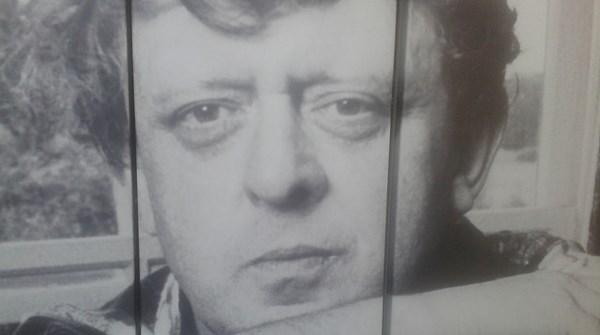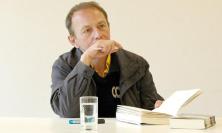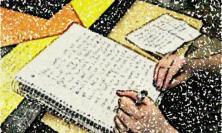25 February 2017 marks the 100th anniversary of the birth of a celebrated author whose complicated relationship with Catholicism shaped his life and particularly his writing. Anthony Burgess, best known for A Clockwork Orange, was fixated on the Church, says Jim Clarke – how did that fascination manifest itself in Burgess’ body of work?
His most famous work is a moral fable about Original Sin and free will. In his finest novel, one of the protagonists is a larger-than-life pope who exorcises the demonically possessed. References to Augustine and Pelagius litter the majority of his fictions. He even worked for years as a commentator on Vatican politics for the Italian press. Yet throughout his life, Anthony Burgess denied that he was Catholic. A century after his birth, England’s most mercurial writer is only now getting the attention his work deserves. And at the heart of that work is the childhood faith he could never quite leave behind.
The author of A Clockwork Orange was born John Wilson in 1917 as the First World War raged. However, it was not war but the subsequent Spanish Flu pandemic that took the lives of his mother and infant sister. Though his father later married into a large Irish family, the young Burgess was a lonely child, an autodidact who taught himself about Modernist music and literature while listening to a wireless he had built to keep himself company.
Raised a ‘Cat-lick’ rather than a ‘Proddy Dog’ in the slang of his childhood, Burgess felt alienated from the Anglican cultural mainstream of England from an early age. His Catholicism was primarily a regional identity. With a religious identity redolent of Ireland and Lancashire recusants, Burgess acknowledged that he was ‘probably three-fourths Irish and one-fourth something else, whatever that is.’
Culturally, being a Catholic placed Burgess outside the history of mainstream English Literature from John Bale onwards, but equally connected him instead to the tradition of art and civilisation that flourished on the European continent, especially in Mediterranean countries. His long exile in Mediterranean Europe, including four years in Rome itself, may be seen as a sort of homecoming. It is perhaps the tension between his sense of exile and his ease in other cultures that differentiates Burgess’ novels from those of the two other English Catholic writers with whom he is most often compared, Graham Greene and Evelyn Waugh.
Burgess’ cultural Catholicism was ruptured by adolescent apostasy, however. This had inevitable painful consequences. To turn his back on the Roman Catholic faith was effectively to refute his recusant cultural origins:
I have a portrait of an ancestor who lost his land to the Crown because he was a Catholic; there is a tradition of an earlier ancestor who lost his life. The family suffered, apparently, so that I could achieve apostasy; an ironical end to the fight for freedom of worship. I am far from happy about this situation, but nobody can actively will loss of faith.
This painful severing from the Church was due largely to the terrifying manner in which Catholic doctrine was transmitted to the faithful when Burgess was a youth. During his childhood, religious education focused on the threat of Hell and damnation, and on the Augustinian notion of Original Sin, which later became a prominent theme in his fiction. The Old Testament conception of God the Father, distant and vengeful, was the cornerstone of Burgess’ Roman Catholic upbringing and inspired the title for his first volume of autobiography, Little Wilson and Big God. If God was envisaged as a ‘vindictive invisibility’, Burgess was later to rationalise, perhaps He took no direct interest in the lives of his creatures on Earth. Equally, He might be the wrong God.
The pain caused by leaving the Church stayed with Burgess throughout his life, and he remained obsessed by its behaviour and beliefs. For many years he reported on Vatican politics for the Italian newspaper Corriere della Sera. His later engagement with Roman Catholicism, especially following the Second Vatican Council, often closely resembled the criticism offered from some traditionalist and conservative quarters within the Church. He even considered a return to Catholicism, despite lacking the ‘spark of faith’. However, the Church of his youth was no more, and he found the reforms of Vatican II impossible to tolerate on an aesthetic level. The turning of the altar was ‘like a butcher’s shop’, priests wore ‘flamboyant neckties’, and the ecclesiastical music of Handel and Purcell had been replaced by excerpts from Godspell. These ‘vulgarities’, which he attributed to the influence of Pope John XXIII, inhibited any possibility of Burgess returning to Catholicism: ‘I tried to get back in [to the Catholic Church] and just at that moment the Pope came up with a new absurdity and I had to turn my back again.’
Burgess’ personal animus against John eventually found fruit in his finest novel, the blockbuster alternative history Earthly Powers, in which the rambunctious exorcist Carlo Campanati is elevated to the papacy. Carlo dines well and often in between visceral battles with evil, wherein he expels demons and tortures Nazis into submission. But in Burgess’ fiction, evil often emerges from good and vice versa. Inevitably, Carlo’s miraculous intervention to save the life of a dying child results in a massacre when the infant grows up to become a Jim Jones figure leading his own death cult.
Having left the Church, Burgess began formulating a theology of his own, drawing heavily on his limited understanding of early church politics. He hypothesised that evil temporarily ruled this plane of existence, in an eternal war with good. Yet his notion transcended good and evil into a more structural binary opposition. In his spy novel, Tremor of Intent, intended as a satire of Ian Fleming, this plays out against the backdrop of the Cold War. The novel’s hero Denis Hillier eventually resolves the apparently unending clash by stepping out of the fray to become a Catholic priest.
To explore this duality, Burgess focused on the doctrines of two early Church theologians, St Augustine of Hippo and the British monk Pelagius. Within this framework, Burgess identified, and often fictionalised, a theological debate that had raged within the early Christian Church as an analogy for the themes that he explored in his fiction. This debate unfolds in his comic Enderby tetralogy in particular, but can be found as early as his first novel, A Vision of Battlements, which fictionalised his wartime experiences in Gibraltar.
Centred on a putative clash between Original Sin and free will, this debate provided Burgess with a set of terms that he and his earliest critics used to describe aspects of his work. Burgess came to accept that no organised religion could accommodate these personal beliefs. He once summarised his theological trajectory: ‘I was brought up a Catholic, became an Agnostic, flirted with Islam and now hold a position which may be termed Manichee – I believe the wrong God is temporarily ruling the world and that the true God has gone under.’
Burgess remained intrigued by any creed that emulated the austere Augustinian beliefs of his childhood. He briefly flirted with converting to Islam during his time as a colonial officer in Malaya, as it evoked for him the ‘puritanical element’ that he felt existed in the ‘Anglo-Irish brand’ of Catholicism of his youth. Burgess was never interested in converting to any form of Protestantism, which he airily dismissed, following James Joyce, as an illogical absurdity. Similarly, despite living in the East and exposing himself to all manner of Oriental beliefs, he felt unmoved by other major religions. ‘I’ve never had any feeling for Buddhism at all,’ he once explained. ‘Never had any feeling for Hinduism. I cannot go along with the Californian Vedantists. I cannot go along with Hinduism at all, nor with Buddhism. But I can go along with Islam, because it’s pretty close to us.’
Burgess hoped that, ‘if I worshipped Allah the God of the Catholics would leave me alone’, but the reality of converting to Islam raised issues that both he and his character Rupert Hardman, who converts in Enemy in the Blanket, found unacceptable. Though Islam features prominently in The Malayan Trilogy, Devil of a State and 1985, and forms part of the cultural background in Napoleon Symphony and Earthly Powers, Burgess’ rejection of Islam was based primarily on what he perceived as hypocrisy among Islamic authorities, which is depicted in both The Enemy in the Blanket and 1985. By the time of the fatwah against Salman Rushdie, his opinion had hardened further to the point where he condemned what he called ‘Islam’s gangster tactics’ in The Independent newspaper. Later again, in his posthumously published verse novel, Byrne, Burgess depicted Islam as a faceless terror campaign.
Despite his theological predisposition, Burgess was insistent that religious themes were an undesirable diminution of the purpose of fiction. He once questioned whether ‘the novel is an unredeemably profane form, and that saints can’t belong there’, but concluded that they ‘can, so long as they are willing to be sinners first.’ This goes some way to explaining the particularly rational and secular depiction of Christ in two of his novels.
Burgess scripted two television miniseries about early Christianity for Franco Zeffirelli (Jesus of Nazareth and A.D.) and adapted his research material into novels: Man of Nazareth and Kingdom of the Wicked, respectively. Unlike the television projects, Burgess had no religious advisers to keep him on the path of orthodoxy when writing fiction, and hence the series and novels differ quite radically, despite being written by the same author from the same research.
The dual role of the Christ-figure, as both God and man, provided Burgess with his favoured binary paradigm, yet the opposition of perfect divinity and fallen man within the same entity has presented many artists with difficulty. How may one depict both adequately and simultaneously? Burgess’ depiction of Christ evades this conundrum by presenting a very human Christ, mediated through the narration of a sceptical fictional author who shares Burgess’ own conception of a duoversal reality.
Burgess’ Jesus is primarily human rather than divine. He depicts a Christ who argues, drinks and even marries. Meditations on the nature of divinity such as those which can be found in Graham Greene’s fiction, and which one might expect to find in a novel about the life of Christ, are strikingly absent. The presence of the divine is restricted to a brief intervention by the disembodied voice at Christ’s baptism, praising the Son in whom He is well pleased. By creating a human rather than a divine Jesus, Burgess pursued the common trend of Christological depiction in the literature of his contemporaries. This all-too-human Christ also populates Jim Crace’s Quarantine, Norman Mailer’s The Gospel According to the Son, and Nikos Kazantzakis’s The Last Temptation of Christ.
As with Alex in A Clockwork Orange, the Jesus of Man of Nazareth is pitted against the power of the state. The dualism in the latter novel then is not that between divine and human, but between individual and state. Burgess’ human, revolutionary messiah is contrasted with the oppressive authoritarian bodies of the political Roman and ecclesiastical Jewish states. The text is curiously unreligious for a novel about Christ, less religious even than Crace’s atheistic but meditative narrative in Quarantine.
As he approached the end of his life, Burgess became calmed by the idea, borrowed from Sir Philip Sidney, that authors can themselves become Godlike by creating their own worlds. God becomes an abstraction in these late novels: an air played on the harpsichord in Mozart and the Wolf Gang, or a tempting thought echoing in the mind of the playwright Christopher Marlowe in A Dead Man in Deptford.
In the years since his death in 1993, Burgess’ star has continued to rise. In this, his centenary year, theatrical performances of A Clockwork Orange are again touring, the BBC is broadcasting his adaptation of Oedipus the King, and his 33 novels are one by one returning to print. His barnstorming literary achievements are increasingly being recognised by academia too, with a three-day conference in his honour scheduled in his native city of Manchester in June, new critical works in the pipeline, and an international team of linguists examining his creation of ‘Nadsat’, the slang in A Clockwork Orange, to discover how translation functions. The lonely teen who was panicked out of faith while reading Doctor Faustus as bombs fell on Manchester during the Blitz, was driven to find meaning in the world through writing about it, and those testaments remain more valid than ever.
Dr Jim Clarke is Senior Lecturer in English and Journalism at Coventry University. He is the author of a book on Burgess’ aesthetics, which is due for publication by Palgrave Macmillan in 2017.
References
Anthony Burgess, ‘The Manicheans’, The Times Literary Supplement, 3340, 3 March 1966.
Walter Clemons, ‘Anthony Burgess: Pushing On’, New York Times Book Review, 29 November 1970.
Earl G. Ingersoll & Mary C. Ingersoll (eds.), Conversations with Anthony Burgess (University Press of Mississippi, 2008).






